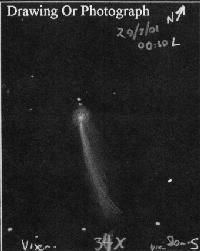
|

|
| One bright Leonid and fainter track below. Sirius is bright star trail.
A time of high activity, note the colours for different parts of the meteor train.
A 10 min exposure with 800 ASA, 28 mm lens on fixed tripod. Time: 1945 UT, 18/12/01.
|
The Milky Way area near the South Celestial Pole. A Leonid fireball near the bright Carina region of the Milky Way. The Southern Cross is rising at the base of the photo.
The fireball had a white head and distinct bluish-white train.
A 10 min exposure with 800 ASA, 28 mm lens. Time: 1925 UT, 18/12/01.
|

|

|
| Several (at least four) meteors streaming out from the radiant, which is at this time close to the horizon. A 10 min exposure, with 800 ASA, 50 mm lens. Time: 1755 UT, 18/12/01.
|
A single bright Leonid passing by M44 - there is also a faint train almost parallel to the bright one but near the bottom of the photo. A 10 min exposure with 800 ASA, 50 mm lens.
Time: 1735 UT, 18/12/01
|

|

|
| Col and Glenda Bembrick's independant observations of the Leonid meteor shower from Carnarvon, WA. The lower line of the graph in each case is the raw counts observed. The upper line is the raw counts corrected for the altitude of the radiant. This gives an approximation towards the true Zenithal Hourly Rate - in counts/hour. The time scale is in Universal Time.
The break in the plot for Glenda is when she was attending to the two still cameras we were running.
At times we were counting up to one/sec for short durations. There were many meteors which had long glowing trains and "exploding" heads. Some trains persisted for up to several minutes. At any one time up to 4 or 5 meteors and their trains could be seen by the naked eye.
|
A CCD image taken from Mt Tarana Observatory on 10th Dec showing the SN discovered by Bob Evans on Monday 10th Dec.
The face-on, barred spiral galaxy is NGS7424 in Grus.
|

|

|
| The image is of comet C/2001 A2(LINEAR) - taken by Col Bembrick, Mt
Tarana Observatory. The image is 19 arcmin wide and 11 arcmin high.
The image was taken on 4th April at 1915 EST, with a 240
sec exposure.
|
Centaurus A or NGC 5128 - combined stack of several images.
This radio source in Centaurus is 3.5 million Parsecs distant from us. Also
known as the hamburger galaxy - for obvious reasons.
|

|

|
| M83 or NGC 5236 - A 60 second integration, with chip binned 3 X 3.
A face-on spiral galaxy in Hydra, approx 4.5 million Parsecs distant.
|
NGC 2997 - A 120 sec integration with the chip binned 2 X 2.
A nice spiral galaxy in Antlia. Approx 10 million Parsecs away. This is the
logo for the Sutherland Astronomical Society.
|

|

|
| The comet picture was taken in late May 2001 by Ray Pickard at the Bathurst Observatory . The image is C14 at F7, 5 minutes on 400 speed.
|
This drawing was made by Ray Pickard viewing Comet C/2001 A2(LINEAR). Scanned from his many fine drawings of this comet.
|

|

|
| This is another drawing made by Ray Pickard viewing Comet C/2001 A2(LINEAR). Scanned from his many fine drawings of this comet.
|
The Omega Centauri Globular cluster is C14 at F7 and 3 minute exposure on 400 speed.
|